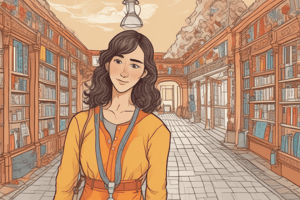Podcast
Questions and Answers
What is the purpose of using cool colors in a 2nd-grade classroom?
What is the purpose of using cool colors in a 2nd-grade classroom?
- To convey a sense of calmness, coolness, and relaxation (correct)
- To create a cheerful and inviting atmosphere
- To evoke specific moods and explore the science behind color and light
- To develop visual literacy and understand color schemes
Which of the following benefits do children gain from being familiar with warm and cool colors?
Which of the following benefits do children gain from being familiar with warm and cool colors?
- Appreciating the beauty and complexity of color
- Creating balanced compositions
- Understanding color schemes
- Developing visual literacy (correct)
What do warm colors convey in a 2nd-grade classroom?
What do warm colors convey in a 2nd-grade classroom?
- A cheerful and inviting atmosphere (correct)
- A tranquil and serene atmosphere
- A sense of calmness, coolness, and relaxation
- A sense of urgency and excitement
How do warm and cool colors help students in their growth?
How do warm and cool colors help students in their growth?
Which colors are considered primary colors?
Which colors are considered primary colors?
What are warm colors known for conveying?
What are warm colors known for conveying?
Which colors are considered secondary colors?
Which colors are considered secondary colors?
What colors are used as the basis for the color wheel and various chemical reactions?
What colors are used as the basis for the color wheel and various chemical reactions?
What are the three primary colors in the visible spectrum?
What are the three primary colors in the visible spectrum?
How are secondary colors created?
How are secondary colors created?
Why are secondary colors vital in understanding color theory?
Why are secondary colors vital in understanding color theory?
What is the purpose of providing students with a color wheel in the classroom?
What is the purpose of providing students with a color wheel in the classroom?
What is the purpose of the 'Color Mixing Experiment' mentioned in the text?
What is the purpose of the 'Color Mixing Experiment' mentioned in the text?
What is the main focus of the 'Color Stories' activity mentioned in the text?
What is the main focus of the 'Color Stories' activity mentioned in the text?
What is the objective of teaching students about tertiary colors?
What is the objective of teaching students about tertiary colors?
What is the purpose of creating a 'Color Mixing Chart' according to the text?
What is the purpose of creating a 'Color Mixing Chart' according to the text?
What does teaching students about 'Color Opposites' involve?
What does teaching students about 'Color Opposites' involve?
What is the aim of asking students to create 'Monochromatic Colors' according to the text?
What is the aim of asking students to create 'Monochromatic Colors' according to the text?
Flashcards are hidden until you start studying
Study Notes
Guessing Colors in a 2nd-Grade Classroom: Exploring Primary, Secondary, Warm, and Cool Colors
In a 2nd-grade classroom setting, color recognition is a fundamental skill that children start developing as they grow. The four main categories we will explore in this article are primary colors, secondary colors, warm colors, and cool colors. By understanding these concepts, students can improve their color identification and have a stronger foundation in visual arts, design, and science.
Primary Colors
Primary colors are the three fundamental colors that can't be created by mixing other colors. They are red, blue, and yellow. These colors are essential in art and science, as they form the basis for the color wheel and various chemical reactions. Children learn these colors early on, as they are simple to distinguish and memorable due to their vibrant hues.
Secondary Colors
Secondary colors are created by mixing two primary colors together. The secondary colors are green (made from blue and yellow), orange (made from red and yellow), and purple (made from red and blue). Secondary colors are generally less intense than the primary colors and are often used in artistic compositions to create harmonious color schemes.
Warm Colors
Warm colors are hues that convey a sense of warmth, energy, and coziness. They include red, orange, and yellow. These colors are typically associated with sunlight, fire, and warmth. In a 2nd-grade classroom, warm colors are often used in artwork or decorations to create a cheerful and inviting atmosphere.
Cool Colors
Cool colors, on the other hand, convey a sense of calmness, coolness, and relaxation. They include blue, green, and purple. These colors are typically associated with water, nature, and nighttime. In a 2nd-grade classroom, cool colors are often used in artwork or decorations to create a tranquil and serene atmosphere.
As children grow, they benefit from being familiar with these color categories. It helps them develop visual literacy, understand color schemes, and appreciate the beauty and complexity of color in their everyday lives. By using warm and cool colors, students can learn to create balanced compositions, evoke specific moods, and even explore the science behind color and light.
In conclusion, the four main categories of color — primary, secondary, warm, and cool — form the foundation of color recognition and exploration for children at a 2nd-grade level. By being familiar with these concepts, students can grow their visual literacy and appreciation for color and its many applications in art, science, and design.
Studying That Suits You
Use AI to generate personalized quizzes and flashcards to suit your learning preferences.




